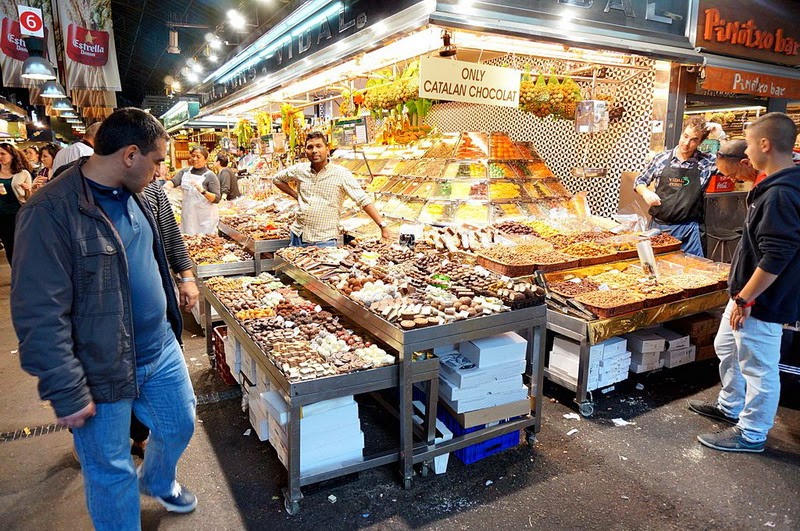海洋聖母教堂(Santa María del Mar),位於西班牙加泰羅尼亞的巴塞隆納舊城區東南部的里貝拉社區(La Ribera),建於1329年至1383年,建築風格屬於加泰羅哥德式建築,是少見的中世紀大型教堂[1]。
歷史[編輯]
最早關於海邊聖母堂的記錄始於998年,重建工程始於1329年3月25日,首席設計師是貝倫格·孟塔古(es)和Ramón Despuig,相關的公會團體在當時也參與了建築工作[2]。1428年,一場地場破壞了西側的玫瑰窗[3],新的火焰式窗於1459年完工[4]。
「海上大教堂」的正式名稱是「海上聖母瑪麗亞教堂」(Esglesia de Santa Marea del Mar)。這座建於14世紀的教堂,堪稱「加泰隆尼亞哥德式」建築的最佳呈現。無庸置疑,巴塞隆納最美的教堂當然是「聖家堂」(Sagrada Familia),但除了「聖家堂」之外,哪一座教堂最美?一般咸認就是坐落於沿海區的「海上聖母瑪麗亞教堂」了。這座教堂雖不具備其他富麗堂皇教堂的宏偉氣派,教堂內部卻能讓人深刻感受到建築師貝倫格.孟塔谷極力呈現的巴塞隆納庶民精神──它是屬於百姓的教堂,由人民所建,為人民而建,彷彿一座加泰隆尼亞大莊園,莊嚴、穩固且可靠。
「海上聖母瑪麗亞教堂」建於1329年到1383年之間,興建時間長達54年,打破了當時的紀錄。其間,
教堂外觀線條俐落,有緣造訪的人可以特別留意教堂正面上方的八邊形鐘樓,非常獨特的建築風格。來到教堂大門前,尤其別忘了看看門上鑲嵌的「大力士」(Bastaixos)雕飾──有關此教堂的興建,這群十四世紀的沿海區搬運工居功厥偉。當時出身卑微的大力士們義務搬運大石塊到聖母教堂,此舉堪稱百姓同心協力建造聖母教堂的最佳示範。對於他們的貢獻,教堂特別感念,直到如今,大力士駝運石塊的銅雕身影依然嵌在教堂大門上,以及內殿的浮雕和大理石石柱上……處處可見那些辛勤奉獻的沿海區搬運工。
此外,「海上聖母瑪麗亞教堂」內部與外觀一樣,就是簡潔,完全沒有贅飾。主祭壇後方的八根石柱呈現了擎天矗立的氣勢,主祭壇上的一尊簡單的小小聖母像,卻在地中海的燦爛陽光下耀眼奪目。光影漫舞的趣味,盡在「海上聖母瑪麗亞教堂」。找個位子坐下,好好欣賞15世紀才增建的大型圓花窗,當艷陽從彩色玻璃折射進來時,整座教堂的空間成了一幅絕美的畫。因為沒有贅飾,因為格局簡單,「海上聖母瑪麗亞教堂」的內部空間顯得格外寬敞。也因為空間未遭切割和阻隔,這座教堂也是舉辦音樂會的首選地點之一,倘若時機正巧,觀光客有可能聽見「海上聖母瑪麗亞教堂」傳出爵士樂的輕快旋律。
之後我哋就行到去巴塞隆納大教堂 (Catedral de
巴塞隆納聖埃烏拉利亞主教座堂(Catedral de Santa Eulalia de Barcelona)是西班牙巴塞隆納哥德區的一座哥德式建築,天主教巴塞隆納總教區的主教座堂。 這座主教座堂興建於13到15世紀,主要工程在14世紀完成。環繞鵝井(Fuente de las Ocas)的迴廊完成於1450年。新哥德式的立面修建於19世紀[1]。
跟住我哋就去呢個好多來巴塞隆納都會去Mercat de Sant Josep 聖約瑟市場,入到去睇下,D嘢都幾貴。重有好多人推介食海鮮個一檔食檔都座滿晒人,不過睇到D海鮮價錢都幾貴~~
The Mercat de Sant Josep de la Boqueria, often simply referred to as La Boqueria (Catalan pronunciation: [ɫə βu.kəˈɾi.ə]), is a large public market in the Ciutat Vella district of Barcelona, Catalonia,Spain and one of the city's foremost tourist landmarks, with an entrance from La Rambla, not far from the Liceu, Barcelona's opera house. The market has a very diverse selection of goods.[1]
History[edit]
The first mention of the Boqueria market in Barcelona dates from 1217, when tables were installed near the old city gate to sell meat. From December 1470 onwards, a pig market was held at this site; at this time it was known as Mercat Bornet. Later, until 1794, it was known simply as Mercat de la Palla, or straw market. In the beginning, the market was not enclosed and had no official status, being regarded simply as an extension of the Plaça Nova market, which extended to the Plaça del Pi.
Later, the authorities decided to construct a separate market on La Rambla, housing mainly fishmongers and butchers. It was not until 1826 that the market was legally recognized, and a convention held in 1835 decided to build an official structure. Construction began on March 19, 1840 under the direction of the architect Mas Vilà. The market officially opened in the same year, but the plans for the building were modified many times. The inauguration of the structure finally took place in 1853. A new fish market opened in 1911, and the metal roof that still exists today was constructed in 1914.


















































沒有留言:
發佈留言
來到留返句說話先走啦...